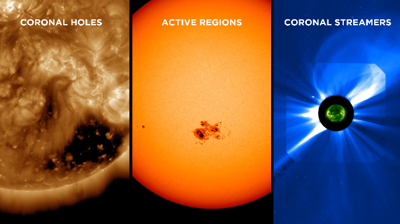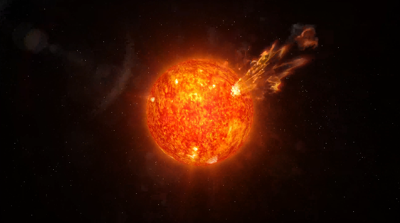What is the solar wind?
From the center of the solar system, rages a powerful wind. Sent by the Sun, this wind whips at speeds exceeding one million miles per hour as it traverses to the edge of interstellar space bathing everything in its path.
1. The solar wind has been blowing non-stop since the Sun formed about 4.6 billion years ago.
2. It travels about 1 million miles an hour.
3. It carries about 1.5 million tons of mass away from the Sun every second.
4. It could keep blowing at that rate for a TRILLION YEARS without depleting the Sun!
That’s a lot of solar wind, so where does it all go? The solar wind fills space around us to create a giant "bubble" we call the heliosphere. The heliosphere’s size, shape, and dynamics are mostly still unknown.

The solar wind starts its journey at the Sun.
It emanates from features on the Sun such as dark and cool regions called coronal holes and active regions, which are characterized by strong magnetic fields.
These regions release solar wind with different speeds and densities. But all release the same basic components of solar wind — electrically charged particles such as protons and electrons.
Through the solar wind, the Sun touches every part of our solar system.
The solar wind’s many impacts include creating auroras and stripping planets’ atmospheres.
As the solar wind gushes out, it drags the Sun’s magnetic field with it. The stretched out solar magnetic field ends up in the shape of a spiral due to the Sun’s rotation.
This spiral was named after preeminent solar scientist Eugene Parker, who developed the first theory of the solar wind in 1958. The first measurement confirming the existence of the solar wind came the following year, with the launch of the first spacecraft to leave Earth’s orbit.
Since the solar wind’s particles are charged, they follow these spiraled magnetic field lines as they burst out from the Sun. As they travel, the particles and magnetic field can create what are known as plasma waves. These waves occur as fluctuating electric and magnetic fields plow through clumps of ions and electrons, pushing some to accelerated speeds.
These plasma waves, like the roaring ocean surf, create a rhythmic cacophony that — with the right tools — we can “hear.” Parker Solar Probe is one spacecraft that can “hear” and record when waves and particles interact with one another in the solar wind.












